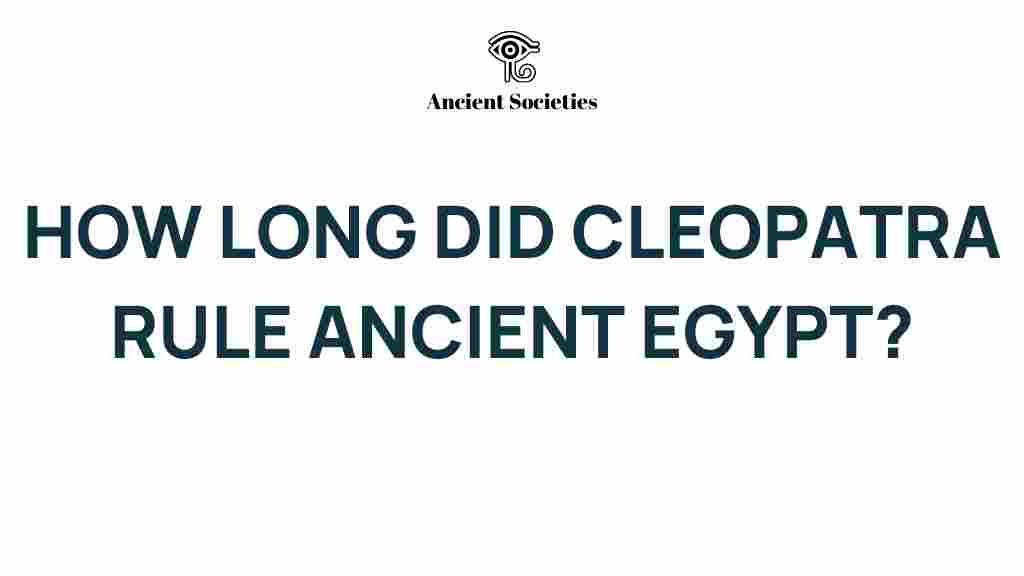Unraveling the Mystery: The Length of Cleopatra’s Reign in Egypt
Cleopatra VII Philopator, the last active ruler of the Ptolemaic Kingdom of Egypt, has captivated the imagination of historians, writers, and the general public for centuries. Her reign marked a significant period in Ancient Egypt’s history, filled with political intrigue, cultural achievements, and dramatic events. In this article, we will delve into the details of Cleopatra’s reign, exploring the timeline of her leadership, the context of her monarchy, and her enduring legacy.
The Timeline of Cleopatra’s Reign
Cleopatra ascended to the throne of Egypt in 51 BC, following the death of her father, Ptolemy XII. Her reign can be divided into several key phases:
- 51 BC: Cleopatra becomes co-regent with her younger brother, Ptolemy XIII.
- 48 BC: The famous Roman general Julius Caesar arrives in Egypt, leading to a significant political alliance.
- 44 BC: Julius Caesar is assassinated, leaving Cleopatra in a precarious position.
- 41 BC: Cleopatra becomes involved with Mark Antony, solidifying her power through this alliance.
- 30 BC: The defeat of Cleopatra and Antony at the Battle of Actium marks the end of her reign and the Ptolemaic dynasty.
Cleopatra’s reign lasted approximately 21 years, from 51 BC until her death in 30 BC. Her leadership was characterized by a blend of political acumen and personal intrigue, as she navigated the complex waters of Roman politics and the shifting loyalties of her own court.
Understanding Cleopatra’s Monarchy
Cleopatra ruled as a queen in a time when Egypt was a client state of Rome. The Ptolemaic dynasty, of which she was the last ruler, was established by Ptolemy I Soter after the death of Alexander the Great. The Ptolemaic rulers were known for their attempts to blend Greek and Egyptian cultures, creating a unique cultural landscape.
As a monarch, Cleopatra was well-educated and spoke multiple languages, including Egyptian, which was rare for Ptolemaic rulers. She portrayed herself as the reincarnation of the goddess Isis, which helped solidify her image and strengthen her claim to the throne. Her reign was marked by several key aspects:
- Political Alliances: Cleopatra’s relationships with powerful Roman figures were crucial in maintaining her rule and protecting Egypt’s interests.
- Cultural Flourishment: Under Cleopatra’s reign, the arts and sciences flourished, with Alexandria becoming a center of learning.
- Economic Challenges: The kingdom faced economic difficulties, which Cleopatra addressed through trade and alliances.
Intrigue and Leadership
Cleopatra’s reign was not without its share of intrigue. The political landscape of Ancient Egypt was fraught with challenges, both from within her court and from external forces. Key events included:
- Conflict with Ptolemy XIII: Cleopatra’s early reign was complicated by her brother’s ambition, leading to a civil war.
- Alliance with Julius Caesar: Her liaison with Julius Caesar was both a love affair and a strategic alliance, allowing her to regain her throne.
- Relationship with Mark Antony: After Caesar’s death, Cleopatra aligned herself with Mark Antony, which ultimately led to her downfall.
Through her political maneuvering and personal relationships, Cleopatra demonstrated remarkable leadership skills. She was known for her intelligence, charisma, and ability to adapt to changing circumstances. However, these same qualities also placed her in vulnerable positions, particularly as Rome’s power expanded.
The Cultural Impact of Cleopatra’s Reign
Cleopatra’s reign significantly influenced the culture of Ancient Egypt and the broader Mediterranean world. Her court was a melting pot of Greek, Roman, and Egyptian influences, fostering a unique cultural identity. Key cultural contributions include:
- Art and Architecture: Cleopatra commissioned numerous building projects, including temples and palaces that blended Hellenistic and Egyptian styles.
- Literature and Philosophy: Alexandria remained a center for intellectual pursuit, attracting scholars and philosophers.
- Religious Syncretism: Cleopatra promoted the worship of Egyptian deities alongside Greek ones, enhancing her image as a divine ruler.
Troubleshooting Historical Misconceptions
There are many misconceptions regarding Cleopatra’s reign and her legacy. Here are some common misunderstandings and the truths behind them:
- Myth: Cleopatra was solely Egyptian.
Truth: Cleopatra was of Macedonian Greek descent and was the first Ptolemaic ruler to learn the Egyptian language. - Myth: Cleopatra was a seductress who used her beauty.
Truth: While she was undoubtedly captivating, her intelligence and political savvy were her true strengths. - Myth: Cleopatra’s reign was insignificant.
Truth: Cleopatra’s reign marked the end of the Ptolemaic dynasty and had lasting effects on Roman history.
Conclusion: The Enduring Legacy of Cleopatra
Cleopatra’s reign in Ancient Egypt was a complex interplay of power, culture, and intrigue. Her ability to navigate the tumultuous political landscape of her time, alongside her cultural contributions, has left an indelible mark on history. Despite the challenges she faced, Cleopatra remains a symbol of female leadership and strength in the face of adversity.
As we unravel the mystery of Cleopatra’s reign, we gain insights not only into her life but also into the broader context of Ancient Egypt and the Ptolemaic dynasty. Her legacy continues to inspire and intrigue, ensuring that her story will be told for generations to come.
For more information on Cleopatra and her impact on history, visit History.com. If you’re interested in exploring more about Ancient Egypt, check out our articles on Egyptian culture and history.
This article is in the category History and created by AncientSocieties Team
